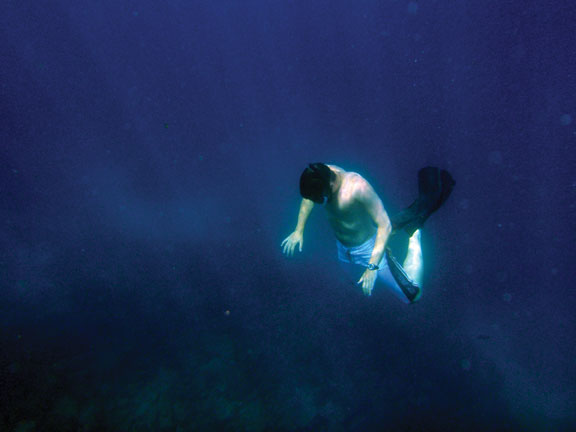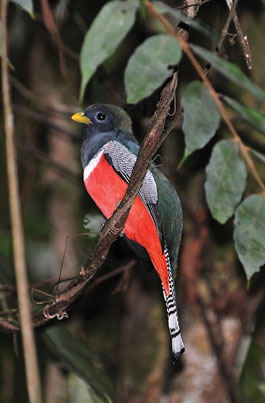End Notes: River Blindnessby David Krohne |
| Printer-friendly version | Email this article |
|
But more important, in the field I see things.
In my occupation there is strong selection pressure for this. My personal adaptive response developed on Saturday morning field trips to California’s Berkeley Hills when I was a teaching assistant in Vertebrate Ecology. Every Saturday at 6 a.m., 10 TAs and 10 groups of students would gather in Strawberry Can-yon, then spread out for the morning’s field work. At 10 a.m. we’d regroup to compare notes. No TA wanted to be the one whose group saw two brown towhees and a couple of song sparrows. We all wanted to lead the group that saw the bobcat, an Allen hummingbird’s courtship display, a golden eagle, and a blue-gray gnatcatcher feeding young in the nest.
So, I learned to see things.
I can still remember walking out of the parking lot and "turning the radar on," as we called it. For teaching, for research, for my avocations, tuning in is essential. I can identify ducks in silhouette at half a mile. I can read the history of a forest as I drive by at highway speed. If my class lists 120 bird species from our Everglades trip, I’ve probably found 90 of them. It’s something I’m good at, something I take some pride in.
Then I met Mayer.
Mayer guided our group of Wabash students and faculty at the Tiputini Biodiversity Reserve in Ecuador this summer. He is a gentle, unassuming man of indeterminate age, his ancestry a combination of Spanish and native. When we met at 5:30 the first morning he said little, just started walking through the forest. I was prepared not to know most of the things we’d see—this isn’t my natural habitat and the field guide to the birds of Ecuador is three inches thick. But I wasn’t prepared to feel blind and deaf.
I’ve been in the field with the best of the best—the folks who write the field guides, the National Academy wildlife biologists, the world-class wildlife photographers—people who see stuff, the ultimate pros.
Then there is Mayer.
At Tiputini, an array of automatic cameras photograph animals on the trails and at salt licks. Over the years they have accumulated 24,000 photographs of rare, cryptic animals, including several hundred of jaguars. When the investigators showed a jaguar photograph to Mayer and the other native guides, they immediately observed that that particular individual must have come from near the river. When pressed, they explained that all the jaguars living right along the river have a distinctive bump on the nose—an observation then confirmed by re-examining all of the jaguar photos in the collection.
How and why would anyone notice this?
So I spent much of the week thinking about seeing. Not visual acuity, but the way the brain sees the world. We learn to see. And of course, this is why each of us sees differently—we’ve learned by habit, by interest, by necessity—to see different things.
The differences are not always explicable. One student in our group was "Mono Man"—he saw monkeys before anyone else in the group picked them out (except Mayer, of course).
Why? Who knows? But I think what we watch and what we see is fundamentally a matter of our unique connections to the natural world. As Aldo Leopold pointed out, deer hunters watch an opening in the forest, duck hunters watch the sky, and grouse hunters watch the dog. A friend of the painter Georgia O’Keefe recalled seeing O’Keefe suddenly look up to stare intently across the Chama River Valley in New Mexico. Thinking she’d spotted an animal, her friend asked what she was looking at. O’Keefe looked surprised and said "color."
Gardeners, painters, birders, hunters, photographers—all of them see the world in a slightly different way. But all of them see, thanks to an intense connection to the natural world.
I came home to TV news reports of the Mississippi in flood and fires in California. I sat dumbfounded as a resident of Gulfport, Illinois, expressed surprise that the river could overtop the levee. And I listened to a resident of Santa Barbara, California, who could not imagine that his canyon could burn. I’ve been to Gulfport. You look up at the barges passing by in the Mississippi. I’ve driven the canyons in Southern California. Chaparral you couldn’t drive a tank through is ready to burn. These things are much easier to see than the eye spot on a gray-breasted saberwing hummingbird as it zips by. But you do have to look.
I think that we see the natural world in proportion to our connection to it. The Alaskan Inuit were aware of global warming before Al Gore convinced all of us except Fox News that it is real. The Huarani Indian huts we passed on the Tiputini River were situated on the highest inside bends of the river. For people who can tell you where a jaguar lives by its profile, recognizing that these sites are protected from floods is hardly a great insight.
What does it say about us if the notion that Gulfport, Illinois, is vulnerable to catastrophic flood lies beyond our perceptive ability? How blind have we become? This contrast in perception is staggering.
The leap I’m making is huge—bumps on jaguar snouts to the Mississippi in flood. But you know, it’s not too big—and it’s precisely that—the gap in our perceptions—that staggers me. The Huarani know the vine that relieves arthritis from the one that yields curare. Their ability to see and perceive is their connection to a world that can kill them or sustain them. It defines the difference between living with the earth and living against the earth. Yet we cannot see a river poised to inundate us or a canyon that is simply a chimney. We have been blinded by the fantasy that we can disconnect from nature. And for this we pay a high price.
Fall is here. In mid-October the warblers pass through Indiana on their way to Central America and on to Tiputini. The mix of juveniles, females, and non-breeding males are referred to in the field guides as "the confusing fall warblers." They seem indistinguishable on the page, let alone flitting through the canopy. But they’re not. Go watch them. Match the bird to the one in the field guide. Struggle with the nuances of color and pattern. See them. Your life will be richer for it. And you will take the first steps toward living with the earth.
David Krohne is Professor of Biology at Wabash, the author of the textbook General Ecology, and is on the board of directors of Niches Land Trust, which protects 25 properties totaling more than 2,300 acres in Indiana.
Photos: Top Photo: Kyle Schroering ’10 dives deep off the Galapagos Islands. Lower Photo: A blue-crowned trogon; how the blue-footed booby got its name.
|

 Crawfordsville, IN, September 2008—I see pretty well. I can still read the bottom line on the eye chart (as long as it’s more than 20 feet away).
Crawfordsville, IN, September 2008—I see pretty well. I can still read the bottom line on the eye chart (as long as it’s more than 20 feet away). On the canopy tower that first morning, every time one of us saw a new bird, Mayer was already training the spotting scope on it. We’d walk through the forest, to us silent and dead, and Mayer would find the flame crested tanager sitting quietly on a branch, camouflaged by the sun flecks filtering through the leaves. He’d stop suddenly and say quietly, "Mono" (monkey). We saw and heard nothing. But five minutes later the troop would move through the canopy above us. When I was disappointed that the hummingbird that buzzed by was a female and thus to me unidentifiable, Mayer pulled out his well-worn field guide—not to look up the bird, but to point to the species (of the 70 in Ecuador) that he had recognized. And as he finished his explanation of the shading of green and the tiny white spot behind the eye, he asked if we’d noticed the half-inch-long poison dart frog 10 feet off the trail to our left. I learned how to see in the rainforest: watch Mayer.
On the canopy tower that first morning, every time one of us saw a new bird, Mayer was already training the spotting scope on it. We’d walk through the forest, to us silent and dead, and Mayer would find the flame crested tanager sitting quietly on a branch, camouflaged by the sun flecks filtering through the leaves. He’d stop suddenly and say quietly, "Mono" (monkey). We saw and heard nothing. But five minutes later the troop would move through the canopy above us. When I was disappointed that the hummingbird that buzzed by was a female and thus to me unidentifiable, Mayer pulled out his well-worn field guide—not to look up the bird, but to point to the species (of the 70 in Ecuador) that he had recognized. And as he finished his explanation of the shading of green and the tiny white spot behind the eye, he asked if we’d noticed the half-inch-long poison dart frog 10 feet off the trail to our left. I learned how to see in the rainforest: watch Mayer.